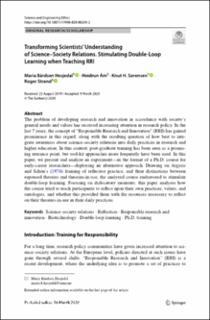| dc.contributor.author | Hesjedal, Maria Bårdsen | |
| dc.contributor.author | Åm, Heidrun | |
| dc.contributor.author | Sørensen, Knut Holtan | |
| dc.contributor.author | Strand, Roger | |
| dc.date.accessioned | 2021-02-19T12:01:33Z | |
| dc.date.available | 2021-02-19T12:01:33Z | |
| dc.date.created | 2020-03-20T16:35:37Z | |
| dc.date.issued | 2020 | |
| dc.identifier.issn | 1353-3452 | |
| dc.identifier.uri | https://hdl.handle.net/11250/2729215 | |
| dc.description.abstract | The problem of developing research and innovation in accordance with society’s general needs and values has received increasing attention in research policy. In the last 7 years, the concept of “Responsible Research and Innovation” (RRI) has gained prominence in this regard, along with the resulting question of how best to integrate awareness about science–society relations into daily practices in research and higher education. In this context, post-graduate training has been seen as a promising entrance point, but tool-kit approaches more frequently have been used. In this paper, we present and analyze an experiment—in the format of a Ph.D. course for early-career researchers—deploying an alternative approach. Drawing on Argyris and Schön’s (1974) framing of reflective practice, and their distinctions between espoused theories and theories-in-use, the analyzed course endeavored to stimulate double-loop learning. Focusing on dislocatory moments, this paper analyses how the course tried to teach participants to reflect upon their own practices, values, and ontologies, and whether this provided them with the resources necessary to reflect on their theories-in-use in their daily practices. | en_US |
| dc.language.iso | eng | en_US |
| dc.publisher | Springer | en_US |
| dc.rights | Navngivelse 4.0 Internasjonal | * |
| dc.rights.uri | http://creativecommons.org/licenses/by/4.0/deed.no | * |
| dc.title | Transforming Scientists’ Understanding of Science–Society Relations. Stimulating Double‑Loop Learning when Teaching RRI | en_US |
| dc.type | Journal article | en_US |
| dc.type | Peer reviewed | en_US |
| dc.description.version | publishedVersion | en_US |
| dc.rights.holder | Copyright The Author(s) 2020 | en_US |
| cristin.ispublished | true | |
| cristin.fulltext | original | |
| cristin.qualitycode | 1 | |
| dc.identifier.doi | 10.1007/s11948-020-00208-2 | |
| dc.identifier.cristin | 1802711 | |
| dc.source.journal | Science and Engineering Ethics | en_US |
| dc.source.pagenumber | 1633–1653 | en_US |
| dc.identifier.citation | Science and Engineering Ethics. 2020, 26, 1633–1653. | en_US |
| dc.source.volume | 26 | en_US |

